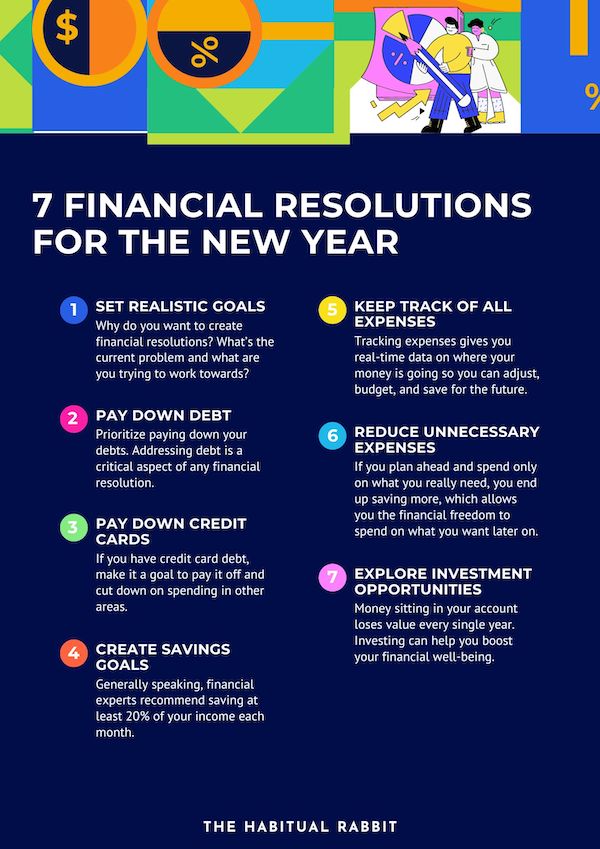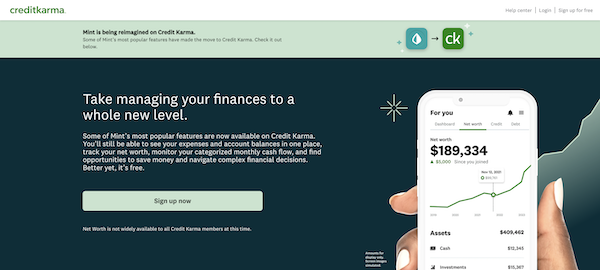
In a previous article, we talked about how New Year’s Resolutions are a thing of the past — traditional resolutions just don’t work. So, instead of focusing on a bunch of arbitrary goals for the year, here’s one goal that I know many people can benefit from — financial resolutions for better financial health.
Finance has been a heavy focus for both Kevin and me over the past few years. I don’t know about you but no one ever talks about money; not friends, not even family. But I know that there’s one thing we can all agree on — money is a significant source of stress.
Concerns about money can have a significant impact on our mental health, which leads to unhealthy decisions with our finances, which puts us in a neverending cycle of bad spending. That’s actually why we decided to write this article on financial resolutions and share this ongoing journey with you, our readers.
I KNOW that all of us want better financial health and to change our habits around spending. But despite setting ambitious financial goals, why do we fail to keep our resolutions when it comes to money?
- It becomes too expensive to keep the resolution.
- Maintaining new habits becomes too challenging.
- Lack of time and impracticality.
- Lack of financial literacy and education.
- Many of us have other responsibilities and support dependents.
When making financial resolutions, one piece of advice is to focus on your biggest problem area. Doing too much at once can be extremely overwhelming, which decreases the chances of you following through on your financial goals.
Like all things, baby steps.
Start with Assessing Your Current Financial Situation
Before you even start thinking about financial goals, you need to gain clarity on your current financial situation. This is a crucial first step toward achieving your goals, and you can do so by creating a personal balance sheet. This involves listing all your assets and liabilities and providing a snapshot of your net worth.
It’s a good idea to recalculate your net worth each year, but like many things, you can decide what works best for you. Personally, Kevin does it every quarter because that’s how he calculates his earnings from derivatives trading, so he ends up recalculating his personal balance sheet along with it. In this case, bundling similar tasks helps him maintain this habit.
If this is too daunting, a more simple task is to create a budgeting spreadsheet where you list out your monthly expenses and create a budget that works within your means. By doing this exercise, you are confronting your spending habits, marking the first step toward making peace with your financial past and getting organized for your financial future.
I struggled with this task for the LONGEST TIME.
But I realized that if I don’t assess where my finances are right now, I wouldn’t be able to plan for the future and would put myself further into debt.
These habits can help you to stay on track with your financial goals while providing valuable feedback on whether you’re earning more than you’re spending or vice versa. It’s hard at first, but like all things, it’ll pave the way for a path towards greater financial stability.

Financial Resolutions for the New Year
1. Set realistic goals
Why do you want to create financial resolutions? What’s the current problem and what are you trying to work towards?
Here are common financial goals that people aim for:
- Paying off debt
- Saving for a significant financial milestone (buying a car or home, having a child, having a wedding)
- Saving for a large purchase (a vacation, new TV, smartphone or other electronic device, new furniture or household appliances)
- Building an emergency savings fund
- Saving for retirement
- Investing more
- Spending on more life experiences
It’s important to understand the underlying reasons driving your financial resolutions and even more important to keep reminding yourself of these reasons. Reaffirming your “whys” will help you stay committed, especially during tough times.
2. Pay down debts
“Debt is one of our main shackles. Our levels of debt and our lack of savings make the nine-to-five routine mandatory” (Dominguez and Robin).
Once you’ve laid out your balance sheet and sorted your financial situation on paper, prioritize paying down your debts. Addressing debt is a critical aspect of any financial resolution. But trust me when I say this is not just an individual problem. America has a problem with debt; from the country as a whole (approaching $34 trillion) down to its citizens. On top of that, we face the current concern that high interest rates and inflation could impede our financial goals for 2024.
The rise of interest rates significantly affects various types of loans including credit cards, auto loans, and mortgages. While these external factors are beyond our control, there are proactive steps to manage our personal debt effectively.
One approach, which I think is the most effective if it’s feasible for you, is to pay more toward the principal on your loans, especially mortgages. This strategy not only earns a risk-free return equivalent to the mortgage interest rate but also accelerates the timeline for paying off the mortgage. Another strategy is to avoid borrowing for depreciating assets, such as cars, which can contribute to debt reduction.
While paying off debt tends to be the most common goal for the new year, financial resolution goals differ by generation. How you look at it and prioritize your goals depends on your own ideas and philosophy around money.
3. Pay down your credit cards
If you’re reading this, more likely than not, this section applies to you.
Despite our challenging economy in the last few years, people are still spending and accumulating credit card debt at alarming rates (yes, even with inflation and high interest rates!).
According to the New York Federal Reserve, “Americans’ total credit card balance is $1.079 trillion in the third quarter of 2023… That’s up from a record $1.031 trillion in the second quarter of 2023, leaving the balance the highest since the New York Fed began tracking in 1999. This marks the second consecutive quarter in which Americans’ credit card balances topped $1 trillion, which had never happened prior to the second quarter of 2023.”
If you have credit card debt, make it a goal to pay it off. Determine how much you can realistically afford to pay off during the year and cut down on spending in other areas. For best results, try not to charge additional purchases on those cards while you’re paying down what you owe.
If you have high-interest credit card balances, consider whether it would be more beneficial to pay off those high-interest debts or add to your savings. There are several approaches you can take, but here are the two most common strategies:
Debt avalanche method: Involves paying off debts with the highest interest rates first. This method can save money on interest.
- What to do:
- Make the minimum payment on each debt.
- Use any extra funds to pay the debt with the highest interest rate.
- Continue paying off your next highest-interest debt.
Debt snowball method: Involves paying off debts in order of smallest to largest.
- What to do:
- Pay off the smallest debt as quickly as possible.
- Pay minimums on all other debts.
- Roll the money you were putting toward the smallest debt onto the next-smallest debt owed.
- Repeat until all accounts are paid off.
4. Create savings goals
When you’re young, you don’t really think too much about this (or maybe you do, which means you’ve got a head start!), but it’s an important habit to instill. Generally speaking, financial experts recommend saving at least 20% of your income each month.
Many people have a Roth IRA or some sort of retirement fund, but if you want to maximize savings for the future, consider a separate, personal savings or investment account you can allocate money to. Better yet, have a set amount from your paycheck auto-deposited into savings. That will make it more cumbersome to spend the money that you have managed to set aside.
By automating your savings process, you avoid the temptation to spend. It can prevent some of those needless buys by removing money from your checking account automatically. For example, when you see that your checking account balance has an extra $300 remaining at the end of the month, it’s easy to be tempted to spend it on something fun. But if that money has already been tucked away in a savings account, there’s zero temptation.
Brilliant, right?
Automating also helps you take forgetfulness out of the equation. Some people slack in the savings department not because they egregiously overspend, but because they simply forget to transfer money from one account to another month after month. No matter your personal objectives, automating your savings will increase your chances of success.
5. Keep track of all your expenses
Track everything!
I have a confession: Before this year, I tried implementing this practice at least a dozen times and failed a dozen times. It was just so difficult for me to track everything; I would always forget, and eventually, the data became too inaccurate due to my inconsistencies. On top of that, I was super avoidant of looking at finances and would literally spend until I had -$0.02 in my bank account.
Can you relate?
Since I started looking closely at my finances and confronting my horrible spending habits, I’ve been able to gain better insight into my current financial situation. This meant that I had an idea of where I was at, which meant that I could make a plan for going forward. This allowed me to adjust, budget, and make saving priorities realistically.
Kevin developed this habit way before me; he’s so good at tracking his expenses! He started by recording all of his expenses – flights, accommodations, subscriptions, daily expenses, and more. Then, he was able to pinpoint which areas he was spending excessively, which allowed him to cut out unnecessary expenses and stick to his budget (most of the time). Finally, he would explore different investment opportunities and diversify his holdings.
It sounds easy when we put it like this, but all of this takes time, so be patient with yourself throughout this process.
Our biggest advice is to use the method that works best for you, that you know you’ll be able to keep track of and be consistent with.
Kevin creates his own spreadsheets for everything and has coded them in a way that works for his method of tracking. For me, I need something more user-friendly and easy on the eyes. So I started using Mint!

Mint (moving to Credit Karma soon) is an app that allows you to record and track expenses, create budgets and savings goals and is basically a one-stop-shop for all your financial organization. It also provides data visualization tools to show how much you spend in different categories.
The best part is that you can link your bank accounts to Mint and it will track your finances across everything!
Start making it a habit to record any and all movements of money, the exact amount, and the reason for the exchange. Every time you spend or receive money, make it second nature to note it instantly. I know it’s hard but the best way to lock down this habit is repetition.
6. Reduce unnecessary expenses
This is different for everyone.
You’ll have to determine what “unnecessary” means for you, but I highly encourage you to be honest and realistic about what you really need and what you just want. As you begin to budget and create savings goals, anticipate your needs.
If you’re able to anticipate what you need in the foreseeable future, make a list of those big purchases in advance so that you can buy them during big sales, like Black Friday. Also equally important is anticipating your grocery needs (running out of cereal soon) or your eating habits (wanting snacks for the weekend) so that you buy them on your trip to Costco instead of paying a premium at the convenience store.
If you plan ahead and spend only on what you really need, you end up saving more, which allows you the financial freedom later on to spend on what you want.
Here are some tips to reduce unnecessary expenses:
- Don’t go shopping – If you don’t go shopping, you won’t spend money. Of course, if you really need something from the store, go and buy it. But don’t just go shopping.
- Take good care of your possessions – Providing better care for machines and appliances, whether it’s an electronic device, a piece of furniture, or a household item, will extend their life.
- Do it yourself – This includes learning to do your taxes, change the tire on your bike, plant your garden, and fix your sink. You can learn all of this for free on YouTube or TikTok now!
- And again… anticipate your needs!
According to the book Your Money or Your Life by Joseph R. Dominguez and Vicki Robin, which we highly recommend reading if you want to transform your relationship with money, the authors beautifully tackle how and why we spend while guiding us to shift our own mindset about our behaviors.
“The invisible catch-22 of the consumer myth of ‘more is better’: If more is better, then what I have is not enough. Even when I do get the “more” I was convinced would make life ‘better,’ however, I am still operating out of the belief that more is better—so the “more” I now have still isn’t enough.”
7. Explore investment opportunities
Money sitting in your account loses value every single year. Investing can help you boost your financial well-being, as it can be a way to outpace inflation and increase your purchasing power.
Consider setting up an investment account for goals with specific timeframes, like early retirement or saving for a house. Research shows it’s extremely difficult to always invest at the “perfect” time. So, create a plan that will help you stay disciplined in all kinds of markets.
Diversifying across different asset classes and diversifying within those asset classes helps reduce risk. For example – if you invest in stocks, make sure your stock holdings don’t take up a sizeable portion compared to your other asset holdings. Within your stock portfolio, make sure that it isn’t heavily in one industry, like tech. If it is, then your portfolio will suffer a lot during periods of economic contraction.
Whatever you do, make sure it fits your long-term goals, risk tolerance, and time frame. Allocate your funds in a way that you’re comfortable with, especially in a down market. The longer your time horizon, the more time you’ll have to potentially benefit from up or down markets.
We are not experts in this area, so we will avoid giving specific financial advice. We advise that you spend the time developing your financial literacy, especially in the area of investment, and learn about various opportunities out there.

